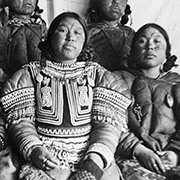CANADA HISTORY
Stalemate

From the formation of the Union of the Union of the Canada's can a realignment of political forces in both Upper and Lower Canada. Rather then a majority English party vs. a minority French party, the philosophies of radicalism and these of conservatives coalesced in both Canada East and Canada West. George Brown led a the new agrarian party in Canada West, known as the Clear Grits with a platform of anti-big, business, more democracy for the voters and an opposition to French Canadian domination. In Canada East the Party Rouge was led by A.A. Dorian and also opposed English business interest such as the Bank of Montréal, the Grand Trunk Railway and various shipping and land companies but differed form the Clear Grits in their policy of protecting French culture.
The establishment interests were led by John A. Macdonald in Western Canada and G.E Cartier in Canada East who led the conservative Bleus. Together they formed the Liberal Conservative party who that only by submerging racial prejudice could they promote the commercial interests of both the English along the St Lawrence valley and their French Canadian partners. The Clear Grits and the Rouge party could not find the common ground to work together in the resistance to the Liberal Conservatives.
The Governments which the Liberal Conservatives formed where assembled only with difficult negotiation and due to slender majorities or even numbers which were a few short of a majority, the clung to power with the support of loose fish. These loose fish were elected as independents and might or might not support the Liberal Conservatives. The working majority was usually just enough o keep the Liberal Conservatives in power. This fractured political makeup led to instability and deadlock.
"We had election after election, we had ministry after ministry, with the same result. Parties were so equally balanced, that the vote of one member might decide the fate of the Administration, and the course of legislation for a year or a series of years. This course of things was well calculated to arouse the earnest consideration of every lover of this country, and I am happy to say it had that effect. None were more impressed by this momentous state of affairs, and the grave apprehensions that existed of a state of anarchy destroyed our credit, destroying our prosperity, destroying our progress, than were the members of this present House; and the leading statesmen on both sides seemed to have come to the common conclusion, that some step must be taken to relieve the country from the deadlock and impending anarchy that hung over us."
John A. Macdonald - February 6, 1865
A new solution had to be found which would break the balance of impasse which had developed in the Union of the Canada's. The unlikely accelerant of this process would be the main critic of the government and the biggest road bloc to a stable system, George Brown.
The political landscape that emerged from the Union of the Canadas in 1841 created a unique and often fractious dynamic, where alliances were shaped more by ideological and economic interests than by purely ethnic or linguistic lines. The delicate balance of power between reformers and conservatives, and between French and English, led to frequent political instability and deadlock. While parties such as the Clear Grits in Canada West and the Parti Rouge in Canada East espoused radically different visions for the future of the colony, they both opposed the entrenched business and political elites who held power through the Liberal Conservative Party, led by John A. Macdonald and George-Étienne Cartier. Yet, the Clear Grits and the Rouge found little common ground to unite their efforts, particularly given their divergent stances on issues like French-Canadian rights and culture.
The Liberal Conservative alliance, though successful in maintaining power, was fragile. This was primarily due to their reliance on slim majorities and the unpredictable support of independent members, known as "loose fish." These independents, elected without a firm party affiliation, could swing the balance of power, making governance precarious. As a result, the Liberal Conservatives often clung to power by the narrowest of margins, and successive elections failed to provide a clear mandate for either side. This deadlock created a growing sense of political instability, as expressed by John A. Macdonald in his 1865 speech. The constant threat of political collapse, compounded by fears of anarchy and economic downturn, put immense pressure on Canada’s political class to find a lasting solution.
It was in this climate of frustration and political deadlock that an unexpected figure emerged as a catalyst for change—George Brown, leader of the Clear Grits and a long-time critic of the Liberal Conservative government. While Brown was known for his vehement opposition to the policies of Macdonald and Cartier, particularly regarding their perceived favoritism towards French Canadians and the business elite, he eventually became a surprising but crucial player in the push for a new political structure that would alleviate the impasse.
The solution that arose from this deadlock was the Confederation of Canada, an idea that sought to unite not only the provinces of Canada East and Canada West, but also the Maritime provinces, into a single federal system. Brown, who had long resisted cooperation with the Conservative government, came to realize that the political gridlock could only be resolved through a fundamental restructuring of the union. Despite his previous opposition to French influence in Canadian politics, Brown recognized the necessity of compromise and played a key role in negotiations leading to Confederation.
By embracing Confederation, Brown and other leaders hoped to achieve several key objectives. First, it would provide a means to resolve the political deadlock in the Union of the Canadas by dividing powers between federal and provincial governments, allowing regional concerns to be addressed more effectively. Second, Confederation would create a more stable and unified political system that could better manage the economic and security challenges facing the colonies, particularly in the face of growing American expansionism. Lastly, the new federal structure would allow for a broader political base, reducing the tensions between French and English by creating a system that accommodated regional autonomy while promoting national unity.
The eventual Confederation of 1867, therefore, can be seen as the culmination of this long-standing political impasse, with George Brown playing a pivotal role in breaking the deadlock that had plagued the Union. His willingness to set aside partisan differences for the sake of political stability was instrumental in bringing about a new era for Canada. Confederation not only resolved the immediate crisis but also laid the foundation for a more resilient political system, ensuring that the young nation could navigate the complex challenges of governance and identity in the years to come. In this sense, the move toward Confederation represented a critical turning point in Canadian history, one driven as much by the need to overcome internal deadlock as by the broader vision of creating a united and prosperous country.
Cite Article : www.canadahistory.com/sections/documents




